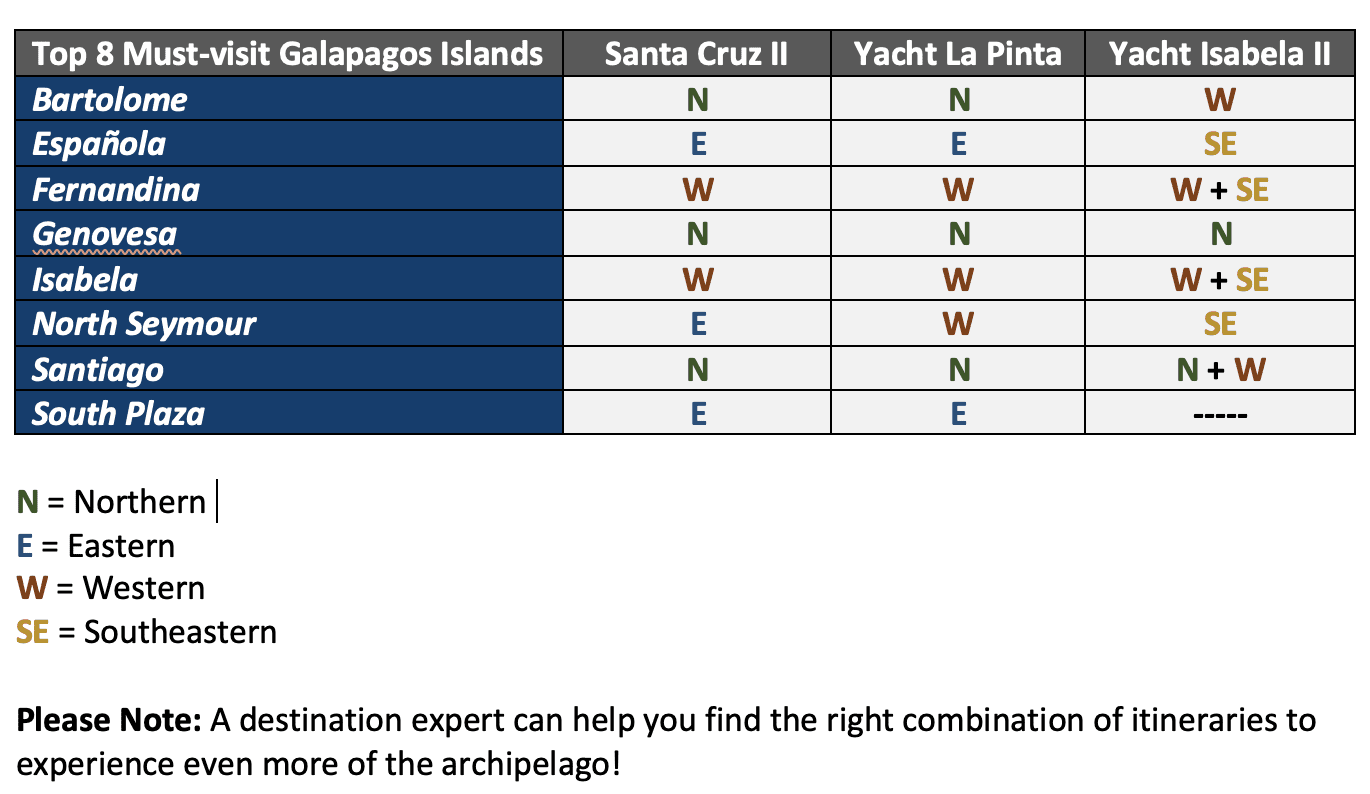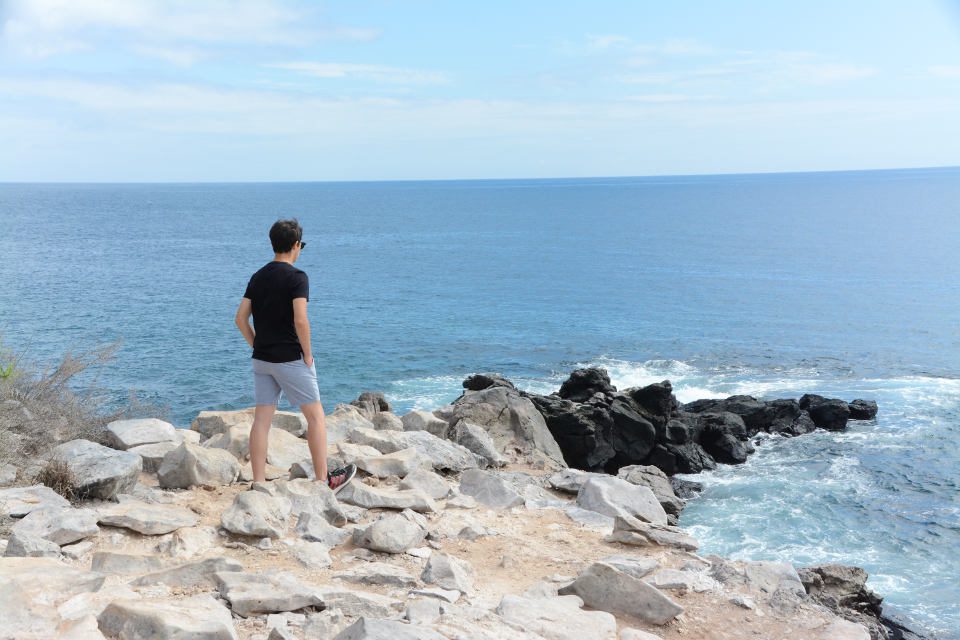The Galapagos Islands are an archipelago comprised of many islands and islets. They are a national park and a UNESCO World Heritage Site and Biosphere Reserve. That said, if you want to truly explore the incredible ecosystems and wildlife in this remarkable destination, here is our definitive guide to the Top 8 Must-visit Galapagos Islands!
Also, the easiest way to maximize your visit to the Enchanted Isles and to see as many of these as you’d like is to book a cruise aboard an expedition vessel with multiple park-certified guides and all the equipment you’ll need to enjoy activities like snorkeling, paddleboarding, kayaking, and more!
Taken from Cruise Critic’s article ‘So Far from Mass Tourism’: How the Galapagos Islands Could Help Restart Cruises:
“One company has already quietly restarted its operations in the Galapagos. Ecuadorian-based Metropolitan Touring resumed its first post-shutdown operations aboard the 48-passenger La Pinta on August 2, 2020, and has committed to operating every sailing — even if only one passenger is onboard.”
TALK TO A DESTINATION EXPERT

Diego Zapata

Rosa Mena

Sandy Lara

Diego Zapata

Rosa Mena

Sandy Lara
Our TOP 8 Must-visit Galapagos Islands in alphabetical order include:
- Bartolome Island
- Española Island
- Fernandina Island
- Genovesa Island
- Isabela Island
- North Seymour Island
- Santiago Island
- South Plaza Island
Things to note: the Galapagos archipelago is quite large. Its land mass measures 3,093 square miles (7,880 square kilometers) and stretches over an area of 17,000 square miles (45,000 square kilometers) in the Pacific Ocean, a size comparable to that of Greece!
In total, the archipelago is made up of 21 islands, 14 of which can be visited. The Galapagos Islands and, by extension, expedition itineraries, are generally divided into different regions (Northern, Southern, Western, Eastern, and Southeastern, offered via different vessels). Each regional itinerary has an allotted number of days/nights (none of which fall under the recommended minimum of 5 days for a proper experience in the Galapagos Islands).
The only two recurring islands you’ll find on each itinerary are the islands of Baltra—where Galapagos’ main airport is located—and Santa Cruz, home to the largest population of inhabitants (known as galapagueños) in the archipelago.
This graphic will help you choose the itinerary in which you will see no less than two of the TOP 8 Must-visit Galapagos Islands!
TOP 8 Must-See Galapagos Islands and how to see them
Now, read on and take a look at the spectacular highlights for each Galapagos Island!
Choose your itinerary and vessel according to your specific interests.
Top 8 must-visit galapagos islands highlights
(As consistently rated by our Galapagos Experts, Expedition Leaders, Guests, and Guides.)
1. Bartolome Island
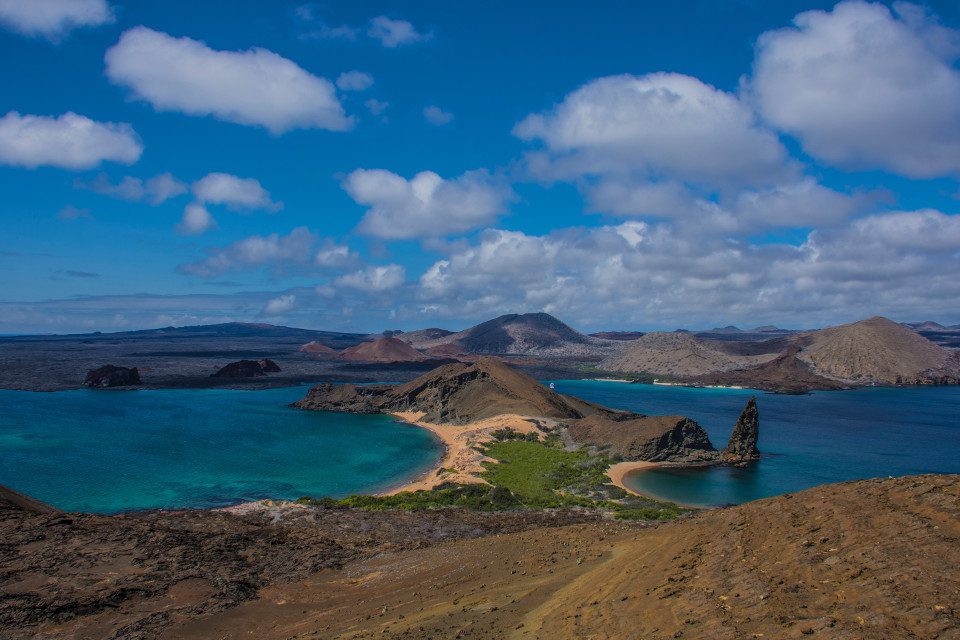
Size: 0.5 mi2 (1.2 km2)
Altitude: 374 ft (114 m)
Coordinates: -0.284136, -90.549907
Estimated Age: Approximately 2 million years old
British Name: Bartholomew
Visitor Sites: Pinacle Rock / Beach, Hillside Viewpoint
Highlights:
- “Postcard Island” – Incredible views and scenery
- Famous Pinnacle Rock
- 5 out of 15 Galapagos BIG15 wildlife: Galapagos penguin, Galapagos sea lion, Galapagos hawk, marine iguana, frigatebird (great and magnificent)
Bartolome Island is famous for several reasons, one of which is the monumental and iconic tower of raw earth that pokes out into the sky known as “Pinnacle Rock.” Leading up to this pinnacle is a relatively long stretch of sandy beach that offers visitors a wonderful spot for snorkeling (as does the beach on the other side of the peninsula).
Heading up the side of the hill that is Bartolome’s large volcanic cone, visitors can climb a staircase almost all the way to the top to get sweeping views of the gorgeous surroundings. This is one of the most photographed places in the entire archipelago.
You can visit this island via Santa Cruz II’s Northern itinerary, Yacht La Pinta’s Northern itinerary, and Yacht Isabela II’s Western itinerary aboard Yacht Isabela II.
2. Española Island
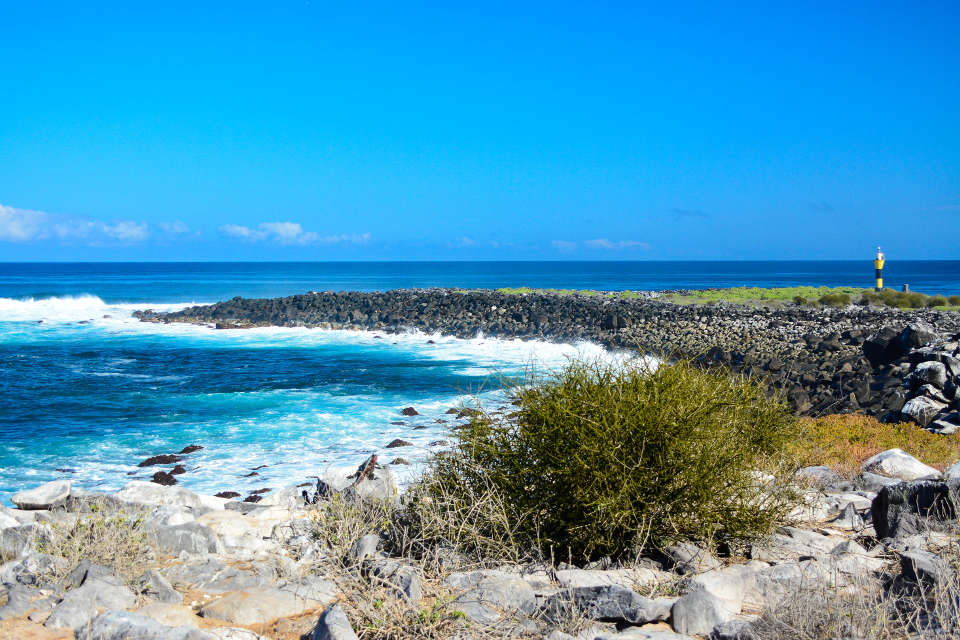
Size: 23 mi2 (60 km2)
Altitude: 676 ft (206 m)
Coordinates: -1.355524, -89.663035
Estimated Age: 4 million years old. Española is the oldest island in the Galapagos.
British Name: Hood
Visitor Sites: Punta Suarez and Gardner Bay
Highlights:
- Overwhelming diversity of wildlife
- Amazing coastline consisting of dramatic cliffs
- Largest nesting colony of blue-footed boobies
- Only island with a colony of Galapagos albatrosses
- Ocean “blowhole” geological formation
- 7 out of 15 Galapagos BIG15 wildlife: Galapagos albatross (Española is the only island where you can see them!), Galapagos sea lion, Nazca booby, blue-footed booby, frigatebird (great and magnificent), Galapagos Hawk, marine iguana
Think of Española Island as the Grand Central Station of wildlife in the Galapagos. Located in the southern region of the archipelago, this is an immensely popular destination due to the sheer variety and number of creatures that inhabit it. Atop the flat and dry terrain, you’ll find the island teeming with a vast number of iconic species.
Fun Fact: Española was the first island observed by Charles Darwin during his epic voyage aboard the HMS Beagle in 1835, although he never landed on it.
Española Island can be visited via Santa Cruz II’s Eastern itinerary, Yacht La Pinta’s Eastern itinerary, and Yacht Isabela II’s Southeastern itinerary.
3. Fernandina Island

Size: 248 mi2 (642 km2)
Altitude: 4,902 ft (1,494 m)
Coordinates: -0.280570, -91.438135
Estimated Age: Geologists estimate Fernandina to be between 80,000 and 800,000 years old. Fernandina is geologically the youngest of all Galapagos Islands.
British Name: Narborough
Visitor Site: Punta Espinosa, Punta Mangle
Highlights:
- Youngest island (in geological terms)
- Surreal, volcanic landscape
- Occasional volcanic activity
- 7 out of 15 Galapagos BIG15 wildlife: Flightless cormorant, marine iguana, Galapagos penguin, sea lion, blue-footed booby, Galapagos sea lion, Galapagos fur seal, (great and magnificent), and Galapagos land iguanas (seldom seen in lower elevations)
This relatively young island is a volcanic canvas of recent lava flows that have painted its terrain, like abstract strokes and swirls of black, igneous rock. Sprinkled across this surreal landscape are clusters of semi-colorful lava cacti surrounded by what appear to be pieces of rock… with tails and feet. As you get a little closer, you’ll find that tens, maybe hundreds, of marine iguanas are present.
Pinning almost the exact center of the island is La Cumbre—a shield volcano made almost entirely out of fluid lava flows. This active behemoth stands at about 4,842 ft (1,476 m) and dominates all other nearby volcanoes by being the most active volcano in the entire archipelago.
Fernandina Island can be visited via Santa Cruz II’s Western itinerary, Yacht La Pinta’s Western itinerary, and Yacht Isabela II’s Western and Southeastern itineraries.
4. Genovesa Island

Size: 5.4 mi2 (14 km2)
Altitude: 249 ft (76 m)
Coordinates: 0.316142, -89.962869
Estimated Age: 2 million years old
British Name: Tower
Visitor Sites: Darwin Bay, Prince Philip’s Steps
Highlights:
- Relatively young lava flows on the flanks of the volcano
- Reputation as “Bird Island” for the large and varied bird colonies that nest here
- 6 out of 15 Galapagos BIG15 wildlife: Galapagos sea lions, Galapagos fur seals, Nazca boobies, frigatebirds (great), red-footed booby, marine iguana
“A world a million miles away from our own.” Genovesa is one of the few islands in the northern region of the archipelago that can be visited, and not all boats in the Galapagos go here. The boats that do go (such as ours!) offer their guests an outstanding experience when it comes to the vast array of birds present as well as the otherworldly scenery on display. Genovesa is the only sunken crater in the whole archipelago that ships can sail into and anchor in.
Genovesa Island can be visited via Santa Cruz II’s Northern itinerary, Yacht La Pinta’s Northern itinerary, and Yacht Isabela II’s Northern itinerary.
5. Isabela Island
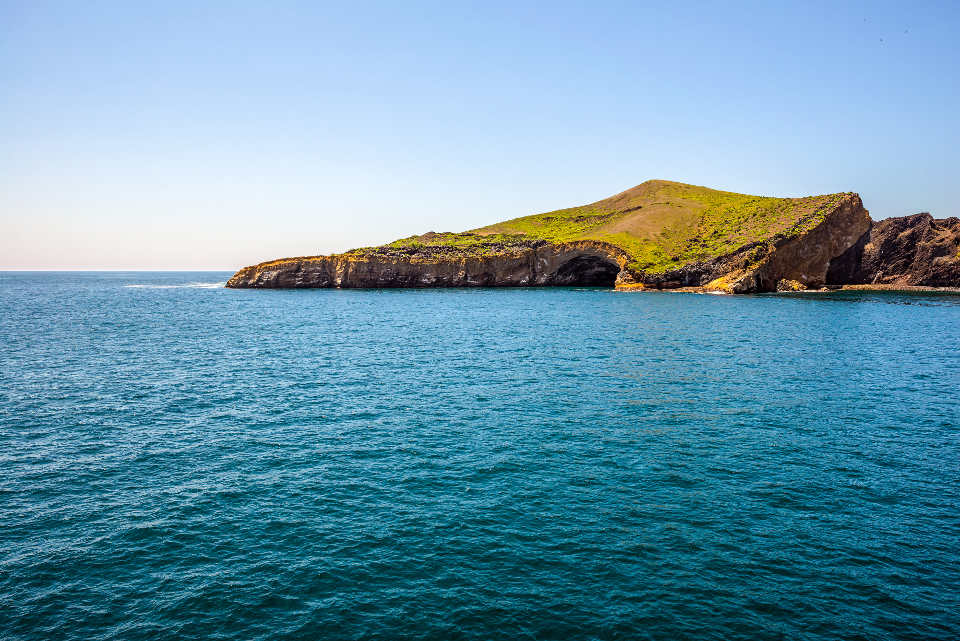
Size: 1,790 mi2 (4,640 km2)
Altitude: 5,600 ft (1,707 m)
Percentage of the island that is populated: 0.78%
Population: 3,568
Coordinates: -0.944888, -90.966880
Estimated Age: Approximately 1 million years old
British Name: Albemarle
Visitor Sites: Punta Vicente Roca, Urbina Bay, Tagus Cove, Punta Moreno, Sierra Negra*, Wall of Tears*, Tintoreras*, Puerto Villamil*
*Only available via island-to-island hopping programs
Highlights:
- Largest island in the archipelago
- Occasional volcanic activity
- 11 out of 15 Galapagos BIG15 wildlife: Blue-footed booby, marine iguana, Galapagos fur seal, Galapagos sea lion, Nazca booby, Galapagos penguin, flightless cormorant, land iguana, Galapagos hawk, frigatebirds (great and magnificent), Galapagos giant tortoise
Isabela Island is the biggest island in the archipelago, home to one of the smallest towns in the Galapagos and one of the biggest craters in the whole world. Whether it’s this peculiar pattern of superlatives that adds to its enigmatic charm or the melancholic bit of history that emanates from the Wall of Tears, Isabela Island captivates visitors in ways that go beyond all things tangible. The island itself is the culmination of six shield volcanoes that have merged into one another, these are: Alcedo, Cerro Azul, Darwin, Ecuador, Sierra Negra, and Wolf. Four of these still show signs of sporadic activity (Wolf, Cerro Azul, Alcedo, and Sierra Negra).
You can visit this island via Santa Cruz II’s Western itinerary, Yacht La Pinta’s Western itinerary, and Yacht Isabela II’s Western and Southeastern itineraries.
Enjoy these Galapagos Itineraries through these wonderful packages!
6. North Seymour Island
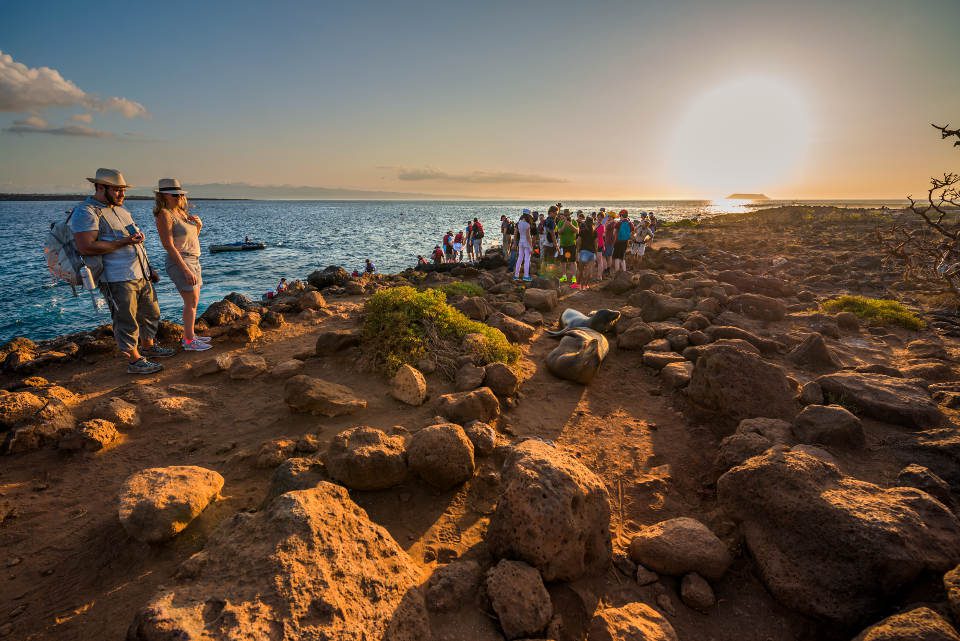
Size: 0.73 mi2 (1.9 km2)
Altitude: 92 ft (28 m)
Coordinates: -0.397352, -90.285394
Estimated Age: 1.3 million years old
British Name: North Seymour Island
Visitor Sites: Trail that takes you through colonies of frigatebirds and blue-footed boobies
Highlights:
- Large colonies of frigatebirds and blue-footed boobies
- Nesting rituals depending on the time of the year
- 7 out of 15 Galapagos BIG15 wildlife: land iguanas, marine iguanas, frigatebirds (great and magnificent), Galapagos sea lions, Galapagos fur seals, blue-footed boobies, Nazca boobies
Small, yet packed with surprises! This is how North Seymour is best described. On this island, you’ll follow the trail through the nesting areas of frigatebirds (great and magnificent). Additionally, you’ll catch a glimpse of the comings and goings of blue-footed boobies. Everywhere you look, wildlife abounds. Talk about feeling the energy of the archipelago! North Seymour was formed by an underwater uplift, and not from volcanic activity.
You can visit this island via Santa Cruz II’s Eastern itinerary, Yacht La Pinta’s Western itinerary, and Yacht Isabela II’s Southeastern itinerary.
7. Santiago Island
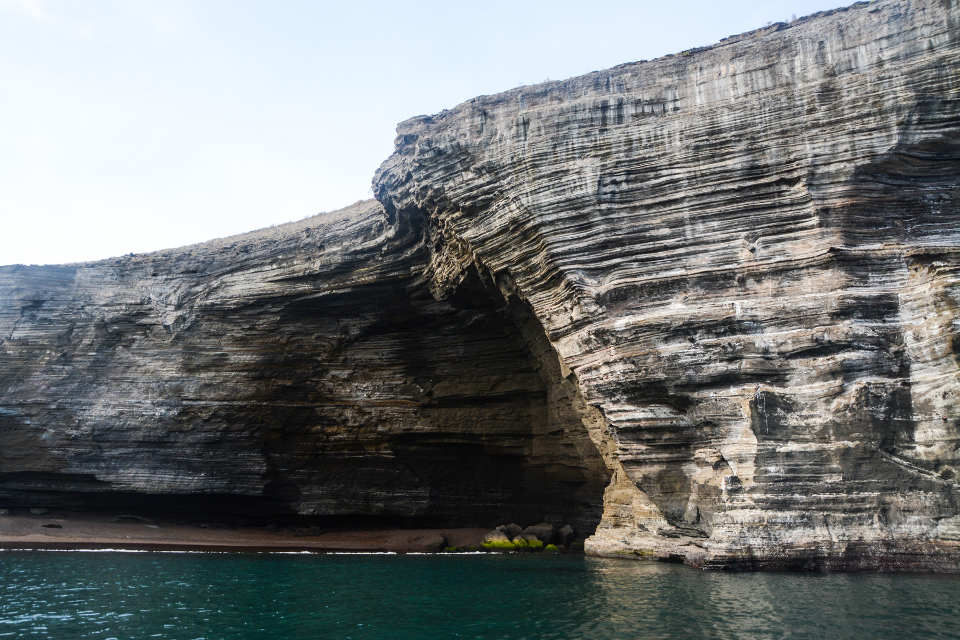
Size: 226 mi2 (585 km2)
Altitude: 2,975 ft (907 m)
Coordinates: -0.259206, -90.840487
Estimated Age: Approximately 1 million years old, with lava flows that are around 100 years old and still forming on the southern part of the island
British Name: James
Visitor Sites: Puerto Egas, Sullivan Bay, Buccaneer Cove
Highlights:
- Contrasting, volcanic layers of age. Special point of interest for people interested in geology, volcanology, or succession. Part of the island is very young (Sullivan Bay), part of it is very old.
- Diverse display of shorebirds
- High chance of seeing the rare Galapagos fur seal
- 6 out of 15 Galapagos BIG15 wildlife: Galapagos sea lion, Galapagos fur seal, marine iguana, blue-footed booby, Nazca booby, frigatebirds (great and magnificent)
This once active large shield volcano looks more like a mountain range complete with hills, valleys, and plenty of parasitic cones. A rugged and well-eroded coastline made of tuff stone lies above a black strip of lava flow. Serving as an archaeological site of sorts, Santiago Island still has remnants of its recent past strewn about. Most of these remnants were left behind by the former salt miners that inhabited the islands for a while (back in the 1960’s), up until their whole operation went bankrupt.
Charles Darwin spent most of his (brief) time in the archipelago at Buccaneer Cove.
You can visit this island as part of Santa Cruz II’s Northern itinerary, Yacht La Pinta’s Northern itinerary, and Yacht Isabela II’s Northern and Western itineraries.
8. South Plaza Island
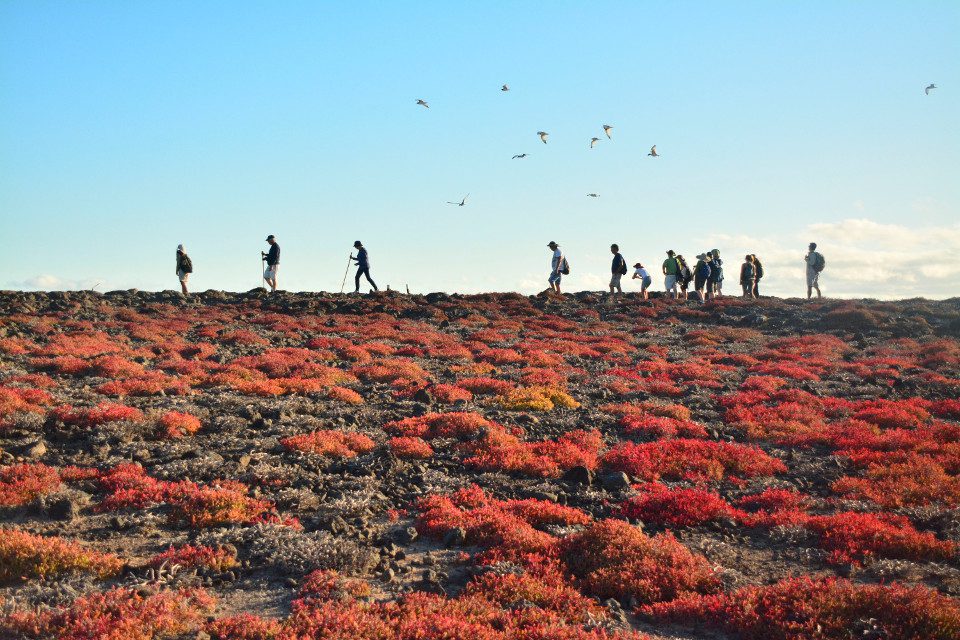
Size: 0.05 mi2 (0.13 km2)
Altitude: 75 ft (23 m)
Coordinates: -0.584264, -90.160794
Estimated Age: 1 to 2 million years old
British Name: N/A
Highlights:
- Much of the island is the result of pillow lava (lava flowing and cooling under the surface of the sea)
- Despite its size, it is home to many species and an extraordinary array of fauna
- Home to one of the largest colonies of Galapagos sea lions in the entire archipelago
- Large colony of land iguanas
- 6 out of 15 Galapagos BIG15 wildlife: Galapagos sea lion, land iguana, marine iguana, frigatebird (great and magnificent), blue-footed booby, Nazca booby
Very nearby to Santa Cruz, North and South Plaza might be rather small islets, but they still pack plenty to see! North Plaza Island is not open to visitors, but South Plaza is, and it offers a terrific little trail. You’ll arrive at the northern shore of South Plaza, which mainly consists of white rocks that have been polished by oily sea lions that have traveled up and down this portion of the island.
The trail on South Plaza will take you through a majestic array of fauna (that includes a decent number of opuntia cacti) up towards the biggest highlight – the bachelor sea lion colony. South Plaza was formed by an uplift of the seafloor.
You can visit this island via Santa Cruz II’s Eastern itinerary or Yacht La Pinta’s Eastern itinerary. (Yacht Isabela II does not currently have an itinerary that includes South Plaza Island.)
Read on! These are the other amazing and unique Galapagos Islands that are also included in the aforementioned itineraries!
The Galapagos Archipelago is composed of 21 islands, of which 14 are visitable. These are the remaining 6 islands you can visit through the itineraries of Galapagos’ modern and comfortable, fully equipped fleet of expedition vessels. Each of these is home to magnificent landscapes, Galapagos wildlife, beaches, and bays that will take your breath away!
9. Sombrero Chino Islet (Chinese Hat)
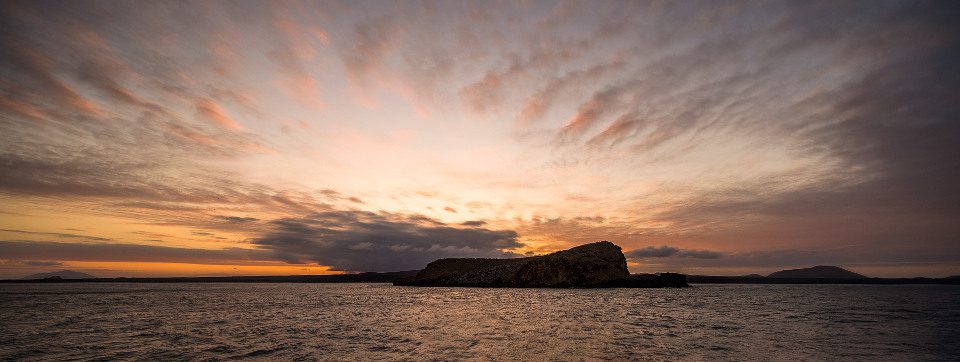
Size: 0.08 mi2 (0.207 km2)
Altitude: 164.04 ft (50 m)
Coordinates: -0.370495, -90.583278
Estimated Age: Approximately 1 million years old
Highlights:
- 0.248 mi (400 m) trail along amazing landscapes
- Beautiful white sandy beach
- Opportunities for snorkeling with white-tip reef sharks and tropical fishes, sea lions and penguins
- 4 out of 15 Galapagos BIG15 wildlife: Marine iguana, Galapagos sea lion, Galapagos penguin, Galapagos hawk
This cute little cinder cone is home to a beautiful moon-shaped white sand beach, perfect for swimming and snorkeling after an invigorating hike along a coastal trail that extends 0.248 mi (400 m). Enjoy some amazing views and get a first-hand understanding of how volcanic activity shaped this amazing archipelago.
You can visit this island via Yacht La Pinta’s Northern itinerary.
10. Santa Fe Island
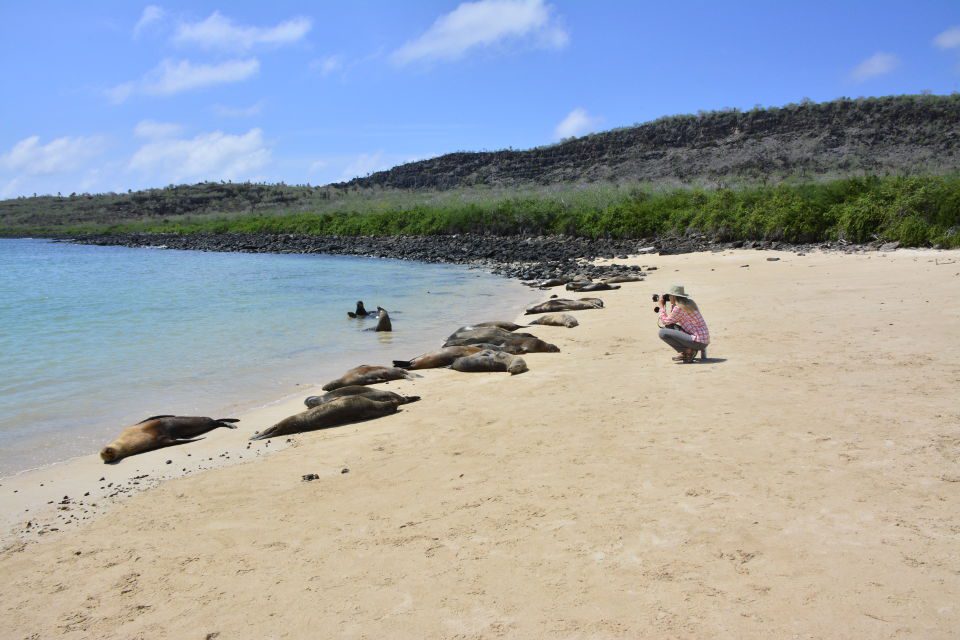
Size: 9.3 mi2 (24 km2)
Altitude: 850 ft (260 m)
Coordinates: -0.806916, -90.062273
Estimated Age: Approximately 4 million years
British Name: Barrington Island
Highlights:
- Endemic species of land iguana known as the Santa Fe iguana
- Large forest of giant prickly pear cactus in the whole archipelago
- Beautiful bay with turquoise waters
- 7 out of 15 Galapagos BIG15 wildlife: Santa Fe iguana, Galapagos hawk, blue-footed booby, Galapagos sea lion, frigatebird (great and magnificent), marine iguana, Nazca booby
In search of something rather unique and special? Santa Fe Island is sure to please visitors with its colony of mustard-colored Santa Fe land iguanas. Guests hoping to take a load off can relax beside sea lions along the sandy shores of the turquoise bay. Studies suggest that Santa Fe Island might be the oldest Galapagos volcano, as there are sub-aerial rocks present that date back approximately 4 million years.
You can visit this island via Santa Cruz II’s Eastern itinerary, Yacht La Pinta’s Eastern itinerary, and Yacht Isabela II’s Northern itinerary.
11. Floreana Island
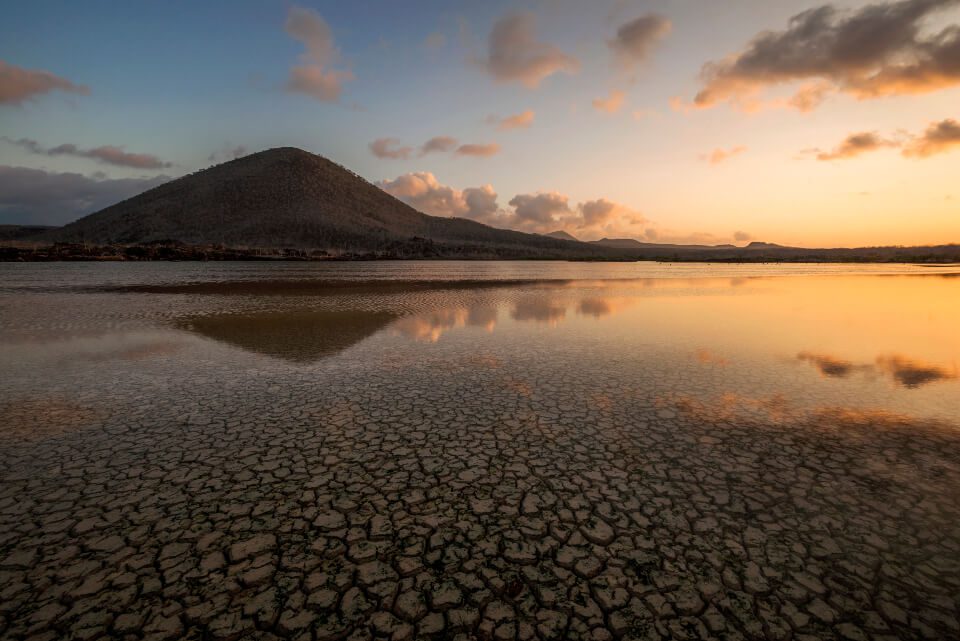
Size: 67 mi2 (174 km2)
Altitude: 2,100 ft (640 m)
Percentage of the island that is populated: 1.79%
Population: 310
Coordinates: -1.279436, -90.486362
Estimated Age: Approximately 3.5 million years old
British Name: Charles
Visitor Sites: Punta Cormorant, Post Office Bay, Champion Islet, Baroness Cove, Asilo de la Paz, Pat´s Landing
Highlights:
- Human history of the island
- Endemic flora and fauna (Floreana lava lizard, medium tree finch, Floreana Mockingbird)
- 6 out of 15 Galapagos BIG15 wildlife: American flamingo, Galapagos sea lion, frigatebird (great and magnificent), marine iguana, blue-footed booby, Galapagos penguin
Teeming with human history and a handful of visitor sites, Floreana is known for its eccentric past. The presence of colonists and visitors on the island was just the beginning of a long series of events that would color the island with history so dramatic that one might even think it came straight out of a Hollywood script.
You can visit this island via Santa Cruz II’s Western itinerary, Yacht La Pinta’s Western itinerary, and Yacht Isabela II’s Southeastern itinerary.
12. San Cristobal Island
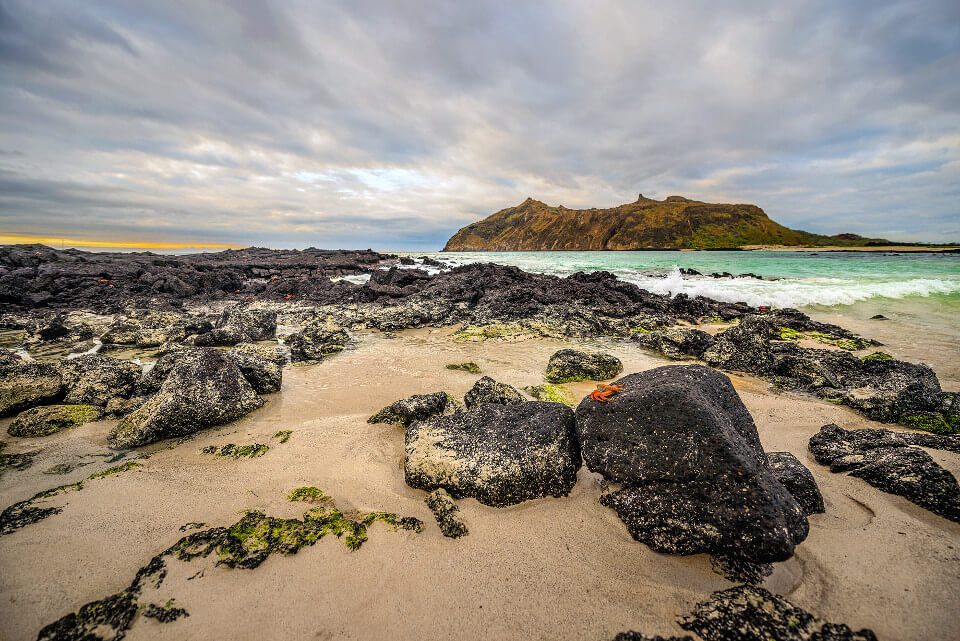
Size: 215 mi2 (557 km2)
Altitude: 2,395 ft (730 m)
Percentage of the island that is populated: 15.04%
Population: approximately 8,393
Coordinates: 0.83°S 89.43°W
Estimated Age: 2.35 million years
British Name: Chatham Island
Visitor Sites: La Galapaguera, Cerro Brujo, Punta Pitt
Highlights:
- Easternmost island in the archipelago
- Capital of the Galapagos province
- One of the two airports that connect to the mainland
- 7 out of 15 Galapagos BIG15 wildlife: Galapagos sea lion, frigatebird (great and magnificent), marine iguana, red-footed booby, blue-footed booby, Nazca booby, Galapagos giant tortoise
The easternmost island of the archipelago, also home to the administrative capital, holds some of the islands’ most iconic scenic highlights. Combine this with the possibility of enjoying local hospitality in the picturesque town of Puerto Baquerizo Moreno, and you’ve got quite a town to enjoy! San Cristobal is the site of the first human settlement in the entire archipelago and is the island where Charles Darwin first disembarked in 1835.
You can visit this island via Santa Cruz II’s Eastern itinerary, Yacht La Pinta’s Eastern itinerary, and Yacht Isabela II’s Southeastern itinerary.
13. Rabida Island
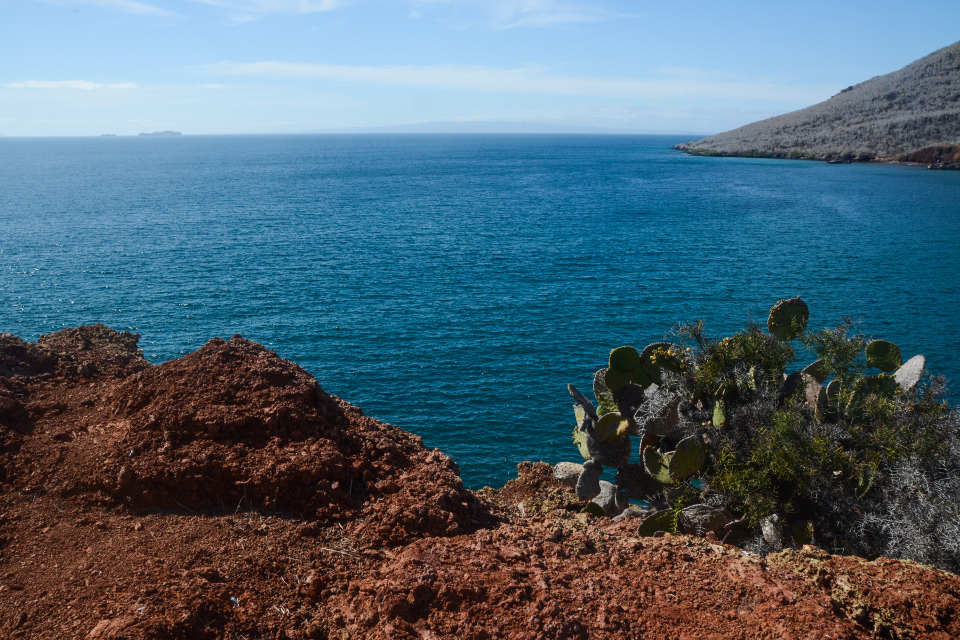
Size: 1.91 mi2 (4.95 km2)
Altitude: 367 m (1204 ft)
Coordinates: -0.418461, -90.710215
Estimated Age: Approximately 2.5 million years old
British Name: Jervis
Visitor Sites: Red Beach
Highlights:
- Distinctly colored beach
- Excellent snorkeling site
- 6 out of 15 Galapagos BIG15 wildlife: Marine iguana, Galapagos hawk, blue-footed booby, Galapagos sea lion, Galapagos fur seal, frigatebird (great and magnificent)
Like stepping off the boat and walking on the surface of Mars, Rabida’s strikingly colored beach offers a real eye-opening experience. Rabida is made up of an interesting palette of colors, including turquoise waters, maroon-colored sandy beaches, white trees, and lush green highlands.
You can visit this island via Santa Cruz II’s Northern itinerary or Yacht La Pinta’s Western itinerary. (Yacht Isabela II does not currently have an itinerary that includes Rabida Island.)
14. Santa Cruz Island
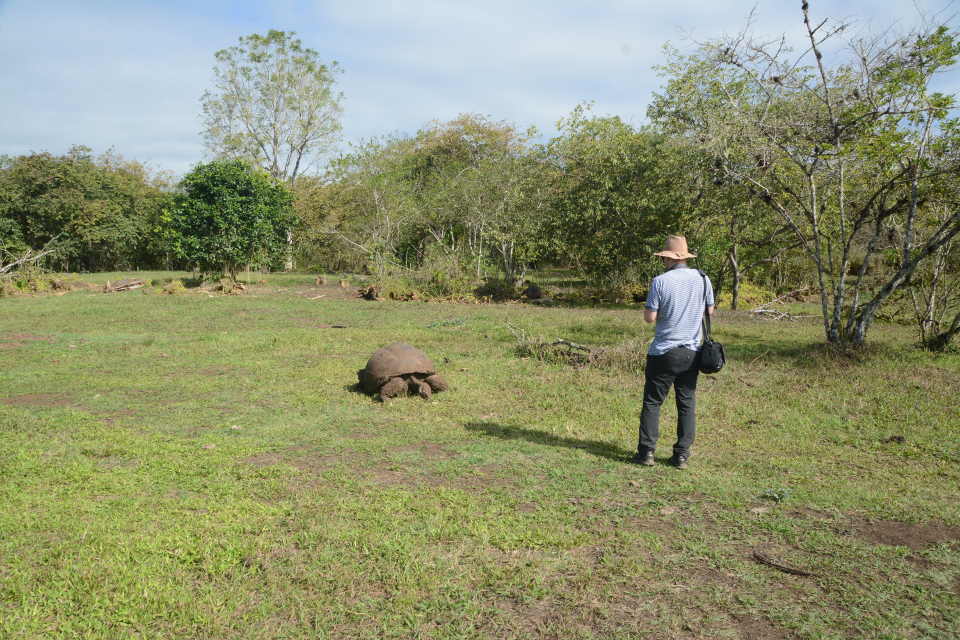
Size: 381 mi2 (986 km2)
Altitude: 864.5 m (2,836 ft)
Percentage of the island that is populated: 11.55%
Population: 11,385
Coordinates: -0.661289, -90.365731
Estimated Age: Approximately 2 million years old
British Name: Indefatigable
Visitor Sites: Puerto Ayora, Charles Darwin Research Station, The Highlands, giant tortoise reserve, Los Gemelos (Pit Craters)*, Cerro Dragon (Dragon Hill), Las Bachas, Tortuga Bay*
*Will depend on time/itinerary
Highlights:
- Charles Darwin Research Station
- Giant tortoises in the wild
- Vegetation in the highlands
- 6 out of 15 Galapagos BIG15 wildlife: Galapagos giant tortoise, frigatebird (great and magnificent), land iguana, blue-footed booby, American flamingo, Galapagos sea lion
Santa Cruz is the second-largest island in the Galapagos and has all seven vegetation zones. In addition to this, the island is home to the largest human population in the archipelago and, consequently, has the biggest town. From restaurants to bars and banks to souvenir shops, Puerto Ayora on Santa Cruz Island is a lively town and one worth exploring.

Javier Garcia

Eduardo Silva

Carolina Escobar
START PLANNING YOUR TRIP

Javier Garcia

Eduardo Silva

Carolina Escobar
Get in touch for more
CONTACT US
You can visit this island via Santa Cruz II’s Eastern, Western, and Northern itineraries, Yacht La Pinta’s Eastern, Northern, and Western itineraries, and Yacht Isabela II’s Northern, Western, and Southeastern itineraries.
